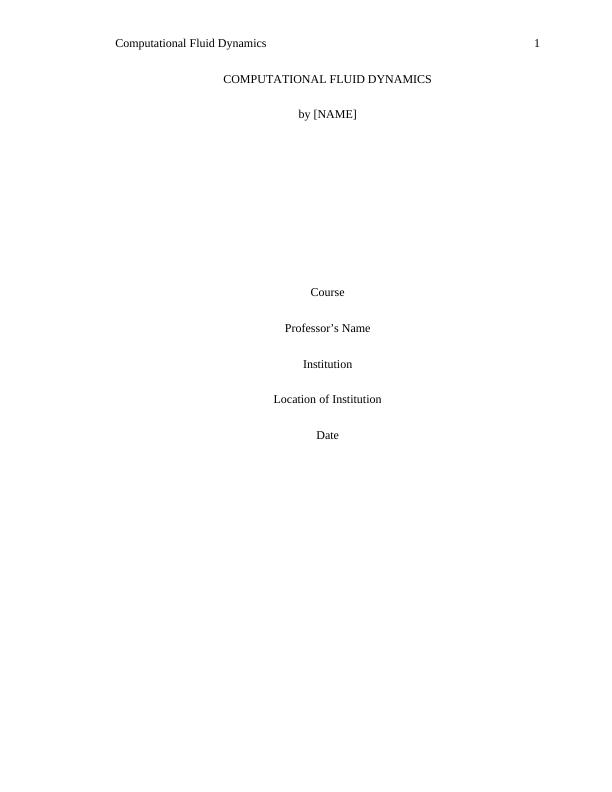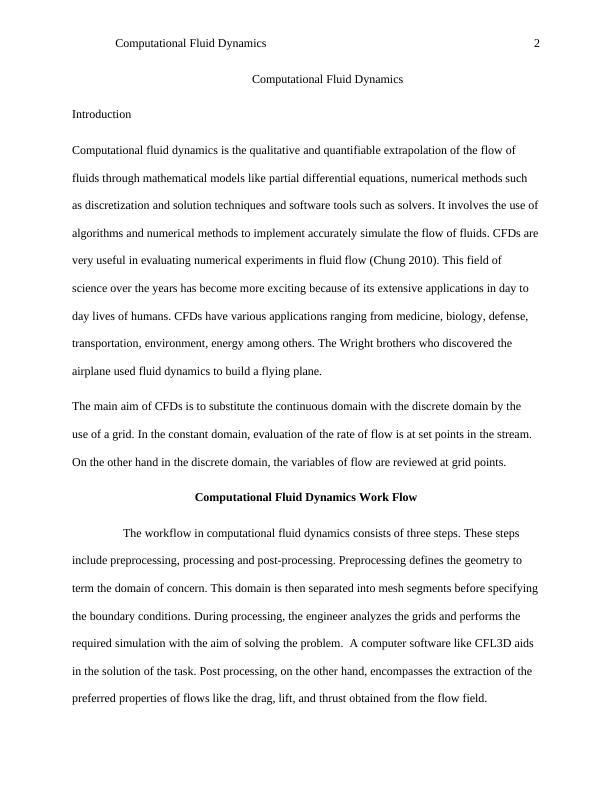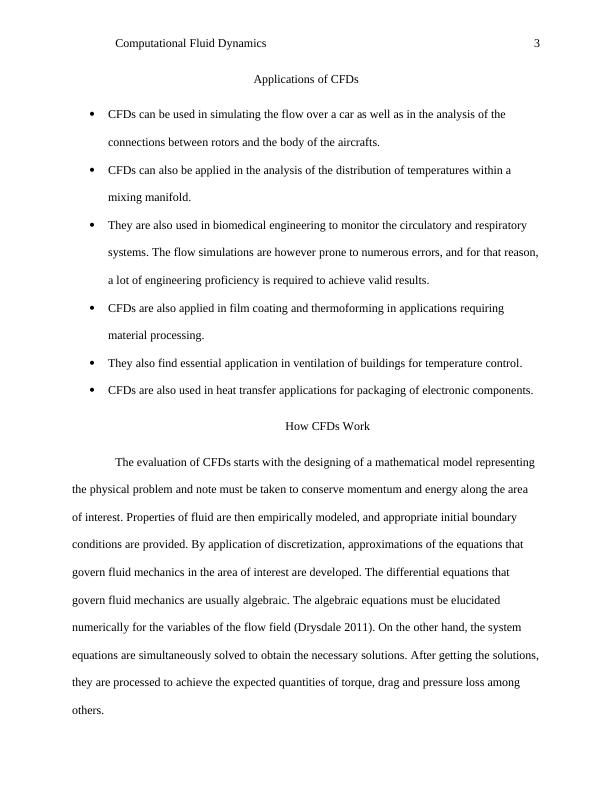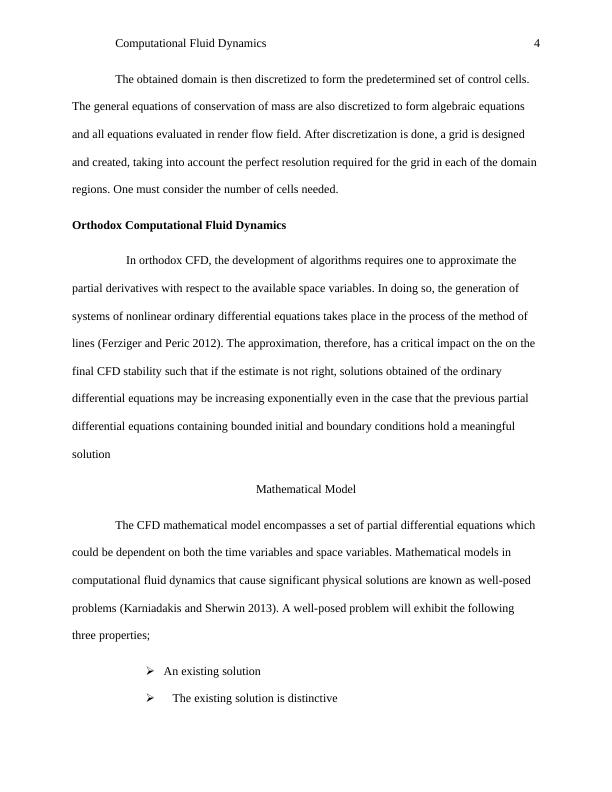Computational Fluid Dynamics - Assignment
11 Pages2410 Words46 Views
Added on 2020-04-15
Computational Fluid Dynamics - Assignment
Added on 2020-04-15
ShareRelated Documents
Computational Fluid Dynamics 1
COMPUTATIONAL FLUID DYNAMICS
by [NAME]
Course
Professor’s Name
Institution
Location of Institution
Date
COMPUTATIONAL FLUID DYNAMICS
by [NAME]
Course
Professor’s Name
Institution
Location of Institution
Date

Computational Fluid Dynamics 2
Computational Fluid Dynamics
Introduction
Computational fluid dynamics is the qualitative and quantifiable extrapolation of the flow of
fluids through mathematical models like partial differential equations, numerical methods such
as discretization and solution techniques and software tools such as solvers. It involves the use of
algorithms and numerical methods to implement accurately simulate the flow of fluids. CFDs are
very useful in evaluating numerical experiments in fluid flow (Chung 2010). This field of
science over the years has become more exciting because of its extensive applications in day to
day lives of humans. CFDs have various applications ranging from medicine, biology, defense,
transportation, environment, energy among others. The Wright brothers who discovered the
airplane used fluid dynamics to build a flying plane.
The main aim of CFDs is to substitute the continuous domain with the discrete domain by the
use of a grid. In the constant domain, evaluation of the rate of flow is at set points in the stream.
On the other hand in the discrete domain, the variables of flow are reviewed at grid points.
Computational Fluid Dynamics Work Flow
The workflow in computational fluid dynamics consists of three steps. These steps
include preprocessing, processing and post-processing. Preprocessing defines the geometry to
term the domain of concern. This domain is then separated into mesh segments before specifying
the boundary conditions. During processing, the engineer analyzes the grids and performs the
required simulation with the aim of solving the problem. A computer software like CFL3D aids
in the solution of the task. Post processing, on the other hand, encompasses the extraction of the
preferred properties of flows like the drag, lift, and thrust obtained from the flow field.
Computational Fluid Dynamics
Introduction
Computational fluid dynamics is the qualitative and quantifiable extrapolation of the flow of
fluids through mathematical models like partial differential equations, numerical methods such
as discretization and solution techniques and software tools such as solvers. It involves the use of
algorithms and numerical methods to implement accurately simulate the flow of fluids. CFDs are
very useful in evaluating numerical experiments in fluid flow (Chung 2010). This field of
science over the years has become more exciting because of its extensive applications in day to
day lives of humans. CFDs have various applications ranging from medicine, biology, defense,
transportation, environment, energy among others. The Wright brothers who discovered the
airplane used fluid dynamics to build a flying plane.
The main aim of CFDs is to substitute the continuous domain with the discrete domain by the
use of a grid. In the constant domain, evaluation of the rate of flow is at set points in the stream.
On the other hand in the discrete domain, the variables of flow are reviewed at grid points.
Computational Fluid Dynamics Work Flow
The workflow in computational fluid dynamics consists of three steps. These steps
include preprocessing, processing and post-processing. Preprocessing defines the geometry to
term the domain of concern. This domain is then separated into mesh segments before specifying
the boundary conditions. During processing, the engineer analyzes the grids and performs the
required simulation with the aim of solving the problem. A computer software like CFL3D aids
in the solution of the task. Post processing, on the other hand, encompasses the extraction of the
preferred properties of flows like the drag, lift, and thrust obtained from the flow field.

Computational Fluid Dynamics 3
Applications of CFDs
CFDs can be used in simulating the flow over a car as well as in the analysis of the
connections between rotors and the body of the aircrafts.
CFDs can also be applied in the analysis of the distribution of temperatures within a
mixing manifold.
They are also used in biomedical engineering to monitor the circulatory and respiratory
systems. The flow simulations are however prone to numerous errors, and for that reason,
a lot of engineering proficiency is required to achieve valid results.
CFDs are also applied in film coating and thermoforming in applications requiring
material processing.
They also find essential application in ventilation of buildings for temperature control.
CFDs are also used in heat transfer applications for packaging of electronic components.
How CFDs Work
The evaluation of CFDs starts with the designing of a mathematical model representing
the physical problem and note must be taken to conserve momentum and energy along the area
of interest. Properties of fluid are then empirically modeled, and appropriate initial boundary
conditions are provided. By application of discretization, approximations of the equations that
govern fluid mechanics in the area of interest are developed. The differential equations that
govern fluid mechanics are usually algebraic. The algebraic equations must be elucidated
numerically for the variables of the flow field (Drysdale 2011). On the other hand, the system
equations are simultaneously solved to obtain the necessary solutions. After getting the solutions,
they are processed to achieve the expected quantities of torque, drag and pressure loss among
others.
Applications of CFDs
CFDs can be used in simulating the flow over a car as well as in the analysis of the
connections between rotors and the body of the aircrafts.
CFDs can also be applied in the analysis of the distribution of temperatures within a
mixing manifold.
They are also used in biomedical engineering to monitor the circulatory and respiratory
systems. The flow simulations are however prone to numerous errors, and for that reason,
a lot of engineering proficiency is required to achieve valid results.
CFDs are also applied in film coating and thermoforming in applications requiring
material processing.
They also find essential application in ventilation of buildings for temperature control.
CFDs are also used in heat transfer applications for packaging of electronic components.
How CFDs Work
The evaluation of CFDs starts with the designing of a mathematical model representing
the physical problem and note must be taken to conserve momentum and energy along the area
of interest. Properties of fluid are then empirically modeled, and appropriate initial boundary
conditions are provided. By application of discretization, approximations of the equations that
govern fluid mechanics in the area of interest are developed. The differential equations that
govern fluid mechanics are usually algebraic. The algebraic equations must be elucidated
numerically for the variables of the flow field (Drysdale 2011). On the other hand, the system
equations are simultaneously solved to obtain the necessary solutions. After getting the solutions,
they are processed to achieve the expected quantities of torque, drag and pressure loss among
others.

Computational Fluid Dynamics 4
The obtained domain is then discretized to form the predetermined set of control cells.
The general equations of conservation of mass are also discretized to form algebraic equations
and all equations evaluated in render flow field. After discretization is done, a grid is designed
and created, taking into account the perfect resolution required for the grid in each of the domain
regions. One must consider the number of cells needed.
Orthodox Computational Fluid Dynamics
In orthodox CFD, the development of algorithms requires one to approximate the
partial derivatives with respect to the available space variables. In doing so, the generation of
systems of nonlinear ordinary differential equations takes place in the process of the method of
lines (Ferziger and Peric 2012). The approximation, therefore, has a critical impact on the on the
final CFD stability such that if the estimate is not right, solutions obtained of the ordinary
differential equations may be increasing exponentially even in the case that the previous partial
differential equations containing bounded initial and boundary conditions hold a meaningful
solution
Mathematical Model
The CFD mathematical model encompasses a set of partial differential equations which
could be dependent on both the time variables and space variables. Mathematical models in
computational fluid dynamics that cause significant physical solutions are known as well-posed
problems (Karniadakis and Sherwin 2013). A well-posed problem will exhibit the following
three properties;
An existing solution
The existing solution is distinctive
The obtained domain is then discretized to form the predetermined set of control cells.
The general equations of conservation of mass are also discretized to form algebraic equations
and all equations evaluated in render flow field. After discretization is done, a grid is designed
and created, taking into account the perfect resolution required for the grid in each of the domain
regions. One must consider the number of cells needed.
Orthodox Computational Fluid Dynamics
In orthodox CFD, the development of algorithms requires one to approximate the
partial derivatives with respect to the available space variables. In doing so, the generation of
systems of nonlinear ordinary differential equations takes place in the process of the method of
lines (Ferziger and Peric 2012). The approximation, therefore, has a critical impact on the on the
final CFD stability such that if the estimate is not right, solutions obtained of the ordinary
differential equations may be increasing exponentially even in the case that the previous partial
differential equations containing bounded initial and boundary conditions hold a meaningful
solution
Mathematical Model
The CFD mathematical model encompasses a set of partial differential equations which
could be dependent on both the time variables and space variables. Mathematical models in
computational fluid dynamics that cause significant physical solutions are known as well-posed
problems (Karniadakis and Sherwin 2013). A well-posed problem will exhibit the following
three properties;
An existing solution
The existing solution is distinctive

End of preview
Want to access all the pages? Upload your documents or become a member.
Related Documents
Fluid Mechanics CFD Analysis of Axial Flow Pumpslg...
|39
|4801
|108
Introduction to CFD in Fluid Dynamicslg...
|30
|3266
|398
Computational Fluid Dynamics (CFD) Analysis: Introduction, Methodology and Applicationslg...
|30
|4008
|380
Advanced Flow Modelling using Computational Fluid Dynamics (CFD)lg...
|19
|2851
|196
Redesigning a Vehicle for Improved Aerodynamicslg...
|26
|4049
|432
CFD Analysis of Screw Compressor using ANSYSlg...
|5
|783
|31
